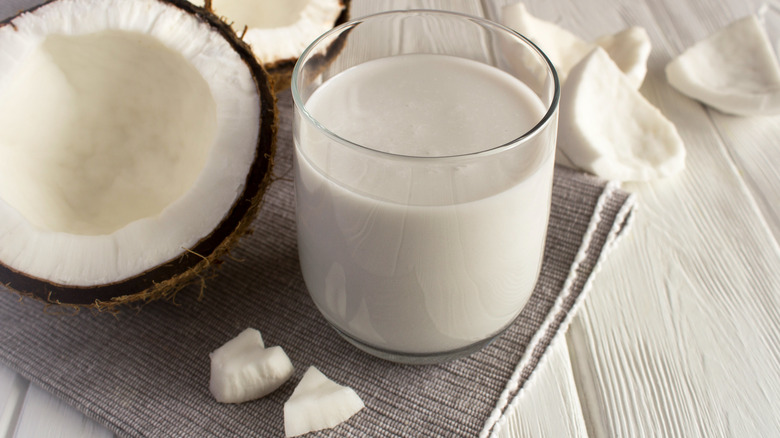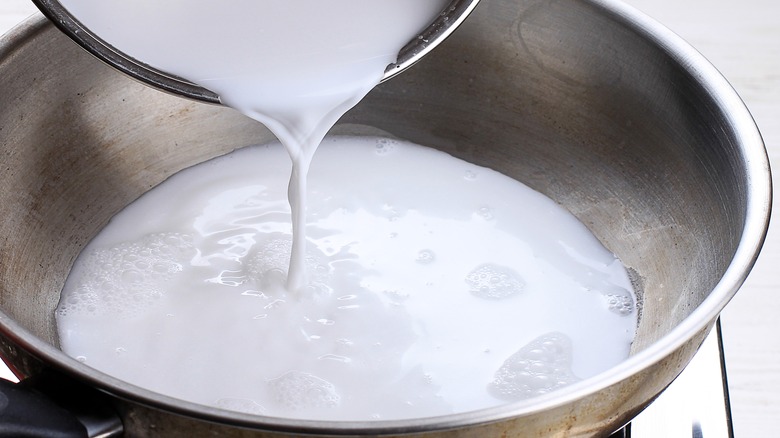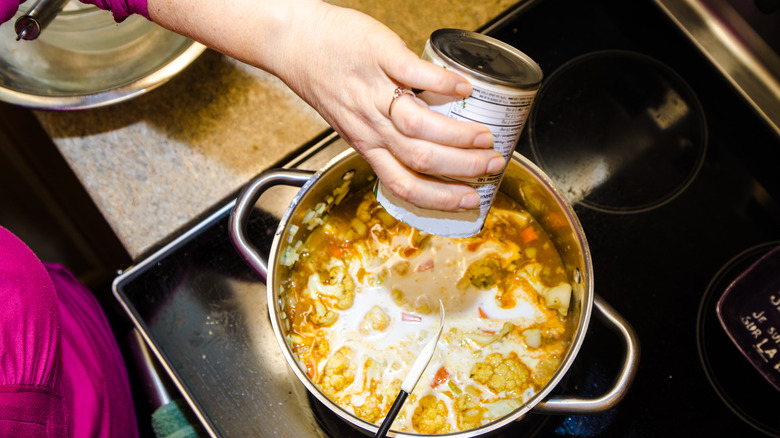The Step You Never Want To Miss After Thawing Frozen Coconut Milk
Ahh, coconut milk. That ever viscous, velvety smooth "milk" derived from the pulp of coconuts blended with water is similar to its bovine counterpart, but 100% vegan and with extra creaminess. Southeast Asian, Asian Pacific, African, Latin and South American, and Caribbean cuisines incorporate coconut milk in traditional dishes; it's often found in curries, rices, and desserts. It's also popular in Brazil cuisine; the country is one of the world's largest producers of coconuts. But every great ingredient has its quirks. When working with thawed, previously frozen coconut milk, you must bring the separated liquid and solids back together in a process called reconstitution. This can be done with an immersion blender, or a regular old kitchen blender if you don't have one.
Reconstitution is an essential step to bringing frozen coconut milk back to life. Miss it, and the product is basically rendered useless, no pun intended.
The generally accepted shelf life of an opened can of coconut milk is seven days with proper refrigeration, so freezing may be a more viable option if you're not planning on using it within that time frame. Coconut milk preserves its freshness for up to thirty days frozen, and is a good staple to have on hand anyway to whip up a quick meal.
How to freeze and thaw coconut milk properly
You can use any airtight container you'd like to freeze leftover coconut milk, but freezer storage bags are preferred, as you can easily extract unwanted air before freezing. Plus, they're space savers. Yet another great space saver are ice cube trays, which work great if you only need to add a small amount of coconut flavor to a dish at a time.
To freeze coconut milk, simply pour the contents into your container, scraping the sides of the can with a spatula to get all of the coconut pieces. Then seal if using a container, or, if using food storage bags, press out any air by squeezing it out of the bag just before sealing. Set your coconut milk container or bag in the freezer and you're done.
When you're ready to use your frozen coconut milk, you'll have to thaw it first and re-emulsify it. Start by removing the frozen coconut milk from the freezer and place on a plate in the refrigerator to thaw. Allow the frozen coconut milk to thaw completely, keeping in mind that the fat solids will thaw slower than the liquid. Once the coconut milk is completely thawed, you'll need to blend the liquid and the fats back together. You can do this with an immersion blender in a mixing bowl, or transfer the coconut milk to a blender and blend the liquid and solids back together.
How to cook with coconut milk
Now that you know how to reconstitute previously frozen coconut milk, it's time to get to work. But before we dive in, we need to break down what you need to know before adding coconut milk to a recipe.
For starters, there are the three different types of coconut milk out there, so be sure to select the right one for the job. They are unsweetened full-fat (the variety you'll typically find in the grocery store and the one which most recipes are referring to), light (which has less than half of the saturated fat of its full-fat counterpart), and coconut milk beverage (which is the coconut version of plant milks). Be sure to always check the can before you purchase in the event that you've picked up the wrong one, or perhaps coconut water, which is entirely different and a refreshing beverage consumed on hot days. To confuse the matter, there are also cream of coconut and coconut cream, which are used in rich baking recipes and for cocktails.
Because of coconut milk's viscosity, it lends itself well to soups, stews, and curry-type dishes, and the sweetened condensed version is popular in baking. You can substitute coconut milk for cow's milk to make dishes vegan or to add flavor. But before opening the can, however, you'll want to give it a good shake, as the contents may have separated.


